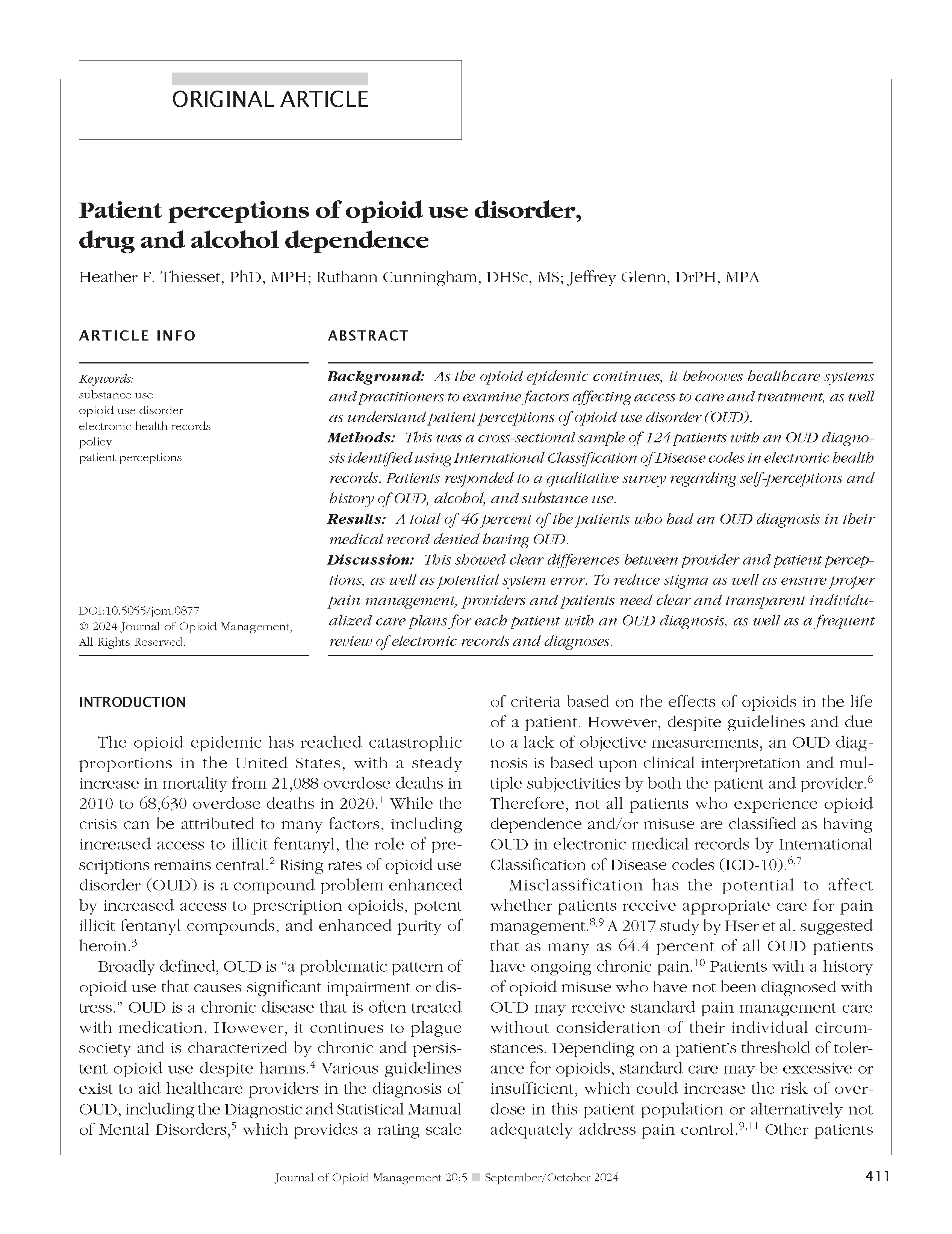Patient perceptions of opioid use disorder, drug and alcohol dependence
DOI:
https://doi.org/10.5055/jom.0877Keywords:
substance use, opioid use disorder, electronic health records, policy, patient perceptionsAbstract
Background: As the opioid epidemic continues, it behooves healthcare systems and practitioners to examine factors affecting access to care and treatment, as well as understand patient perceptions of opioid use disorder (OUD).
Methods: This was a cross-sectional sample of 124 patients with an OUD diagnosis identified using International Classification of Disease codes in electronic health records. Patients responded to a qualitative survey regarding self-perceptions and history of OUD, alcohol, and substance use.
Results: A total of 46 percent of the patients who had an OUD diagnosis in their medical record denied having OUD.
Discussion: This showed clear differences between provider and patient perceptions, as well as potential system error. To reduce stigma as well as ensure proper pain management, providers and patients need clear and transparent individualized care plans for each patient with an OUD diagnosis, as well as a frequent review of electronic records and diagnoses.
References
NIH NIoDA: Opioid overdose crisis. 2021. Available at https://www.drugabuse.gov/drug-topics/opioids/opioid-overdose-crisis. Accessed April 1, 2023.
Upp LA, Waljee JF: The opioid epidemic. Clin Plast Surg. 2020; 47(2): 181-190. DOI: https://doi.org/10.1016/j.cps.2019.12.005
Hoffman KA, Ponce Terashima J, McCarty D: Opioid use disorder and treatment: Challenges and opportunities. BMC Health Serv Res. 2019; 19(1): 884. DOI: https://doi.org/10.1186/s12913-019-4751-4
Taylor JL, Samet JH: Opioid use disorder. Ann Intern Med. 2022; 175(1): itc1-itc16. DOI: https://doi.org/10.7326/AITC202201180
Battle DE: Diagnostic and statistical manual of mental disorders (DSM). Codas. 2013; 25(2): 191-192.
Howell BA, Abel EA, Park D, et al.: Validity of incident opioid use disorder (OUD) diagnoses in administrative data: A chart verification study. J Gen Intern Med. 2021; 36(5): 1264-1270. DOI: https://doi.org/10.1007/s11606-020-06339-3
Blackley SV, MacPhaul E, Martin B, et al.: Using natural language processing and machine learning to identify hospitalized patients with opioid use disorder. In AMIA Annual Symposium Proceedings. AMIA Symposium, 2021. 2020: 233-242.
Thiesset HF, Schliep KC, Stokes S, et al.: Opioid Misuse and Dependence Screening Practices Prior to Surgery. J Surg Res. 2020; 252: 200-205. DOI: 10.1016/j.jss.2020.03.015. DOI: https://doi.org/10.1016/j.jss.2020.03.015
Herscher M, Fine M, Navalurkar R, et al.: Diagnosis and management of opioid use disorder in hospitalized patients. Med Clin North Am. 2020; 104(4): 695-708. DOI: https://doi.org/10.1016/j.mcna.2020.03.003
Hser YI, Mooney LJ, Saxon AJ, et al.: Chronic pain among patients with opioid use disorder: Results from electronic health records data. J Subst Abuse Treat. 2017; 77: 26-30. DOI: https://doi.org/10.1016/j.jsat.2017.03.006
Donroe JH, Holt SR, Tetrault JM: Caring for patients with opioid use disorder in the hospital. CMAJ. 2016; 188(17-18): 1232-1239. DOI: https://doi.org/10.1503/cmaj.160290
Lagisetty P, Garpestad C, Larkin A, et al.: Identifying individuals with opioid use disorder: Validity of international classification of diseases diagnostic codes for opioid use, dependence and abuse. Drug Alcohol Depend. 2021; 221: 108583. DOI: https://doi.org/10.1016/j.drugalcdep.2021.108583
Madden EF, Prevedel S, Light T, et al.: Intervention stigma toward medications for opioid use disorder: A systematic review. Subst Use Misuse. 2021; 56(14): 2181-2201. DOI: https://doi.org/10.1080/10826084.2021.1975749
Kreuzthaler M, Pfeifer B, Vera Ramos JA, et al.: EHR problem list clustering for improved topic-space navigation. BMC Med Inform Decis Mak. 2019; 19(Suppl. 3): 72. DOI: https://doi.org/10.1186/s12911-019-0789-9
Brown KG, Capili BCE: Opioid use disorder: Pathophysiology, assessment, and effective interventions. Am J Nurs. 2020; 120(6): 38-46. DOI: https://doi.org/10.1097/01.NAJ.0000668736.80609.4e

Published
How to Cite
Issue
Section
License
Copyright 2005-2025, Weston Medical Publishing, LLC and Journal of Opioid Management. All Rights Reserved.










